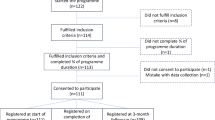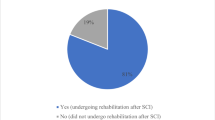Abstract
Study design
Retrospective cohort study.
Objectives
To evaluate the effects of two periods of rehabilitation among people with spinal cord injury (SCI).
Setting
Shanghai Sunshine Rehabilitation Center (SSRC), China.
Methods
A total of 130 people with SCI who received two periods of rehabilitation participated in the study. Outcome measures included basic life skills (15 items) and their applications in family and social life (8 items). Six factors were identified from the 23 items by factor analysis: self-care and transfer skills; basic life skills application in social life; cognition and emotion; basic life skills application in family life; walking and climbing stairs; and wheelchair skills. Standardized scores ranging from 0 to 100 were used to show the rehabilitation outcome in a histogram.
Results
Median scores for self-care and transfer skills, wheelchair skills, cognition and emotion, and their applications in family and social life improved significantly (7−80%, p < 0.01) over the first rehabilitation period, while no improvement was observed in walking and climbing stairs. Five factors showed a significant sustained effect (p < 0.01) upon admission to the second rehabilitation period, except walking and climbing stairs. By enrolling in the second period of rehabilitation, participants acquired significant additional improvement (5−43%, p < 0.01) in rehabilitation outcomes, except in cognition and emotion, walking and climbing stairs.
Conclusions
Two periods of rehabilitation were efficacious at increasing the abilities of basic life skills and their applications in family and social life. The potential benefits of continuous rehabilitation merit further research.
Similar content being viewed by others
Log in or create a free account to read this content
Gain free access to this article, as well as selected content from this journal and more on nature.com
or
Data availability
The data that support the findings of this study are available from the authors upon reasonable request and with the permission of the SSRC.
References
Yang ML, Li JJ, Li Q, Qiu ZY, Chen C, Gao F. Clinic and rehabilitation pathway recommendation for spine and spinal cord injury. Chin J Rehabil Theory Pract. 2012;18:791–6. (in Chinese)
Li J, Liu G, Zheng Y, Hao C, Zhang Y, Wei B, et al. The epidemiological survey of acute traumatic spinal cord injury (ATSCI) of 2002 in Beijing municipality. Spinal Cord. 2011;49:777–82.
Chang FS, Zhang Q, Sun M, Yu HJ, Hu LJ, Wu JH, et al. Epidemiological study of spinal cord injury individuals from halfway houses in Shanghai, China. J Spinal Cord Med. 2017;41:450–8.
Cheng CL, Plashkes T, Shen T, Fallah N, Humphreys S, O’Connell C, et al. Does specialized inpatient rehabilitation affect whether or not people with traumatic spinal cord injury return home? J Neurotrauma. 2017;34:2867–76.
Turner-Stokes L, Vanderstay R, Stevermuer T, Simmonds F, Khan F, Eagar K. Comparison of rehabilitation outcomes for long term neurological conditions: a cohort analysis of the Australian rehabilitation outcomes centre dataset for adults of working age. PLoS ONE. 2015;10:e132275.
Guihan M, Bombardier CH, Ehde DM, Rapacki LM, Rogers TJ, Bates-Jensen B, et al. Comparing multicomponent interventions to improve skin care behaviors and prevent recurrence in veterans hospitalized for severe pressure ulcers. Arch Phys Med Rehabil. 2014;95:1246–53.
Hachem LD, Ahuja CS, Fehlings MG. Assessment and management of acute spinal cord injury: From point of injury to rehabilitation. J Spinal Cord Med. 2017;40:665–75.
Tse CM, Chisholm AE, Lam T, Eng JJ. A systematic review of the effectiveness of task-specific rehabilitation interventions for improving independent sitting and standing function in spinal cord injury. J Spinal Cord Med. 2018;41:254–66.
Truchon C, Fallah N, Santos A, Vachon J, Noonan VK, Cheng CL. Impact of therapy on recovery during rehabilitation in patients with traumatic spinal cord injury. J Neurotrauma. 2017;34:2901–9.
Bi JX, Yu ZH, Wang SL. Impact of rehabilitation training on spinal cord injury patients. J Qilu Nurs. 2011;20:38. (in Chinese)
Shen HL, Wu GQ, Pan YQ. Outcomes of rehabilitation training of 106 spinal cord injury patients. Fujian Med J. 2017;39:162–3. (in Chinese)
Chan SC, Chan AP. Rehabilitation outcomes following traumatic spinal cord injury in a tertiary spinal cord injury centre: a comparison with an international standard. Spinal Cord. 2005;43:489–98.
Wang YY, Yang M. Effects of family rehabilitation training and nursing on the prognosis of patients with spinal cord injury and paraplegia. Hainan Med J. 2014;25:1862–4. (in Chinese)
Ru ZH, Wu H. Effects of community rehabilitation guidance on the complications and quality of life of patients with spinal cord injury. Chin Rural Health Serv Adm. 2013;33:1231–3. (in Chinese)
Xie HX, Chang FS, Shen C, Shen XY, Zhang J, Lin PP, et al. Factors influencing the outcomes of specialized institution-based rehabilitation in spinal cord injury. Chin J Spine Spinal Cord. 2018;28:529–34. (in Chinese)
Hou CL, Fan ZP, Wang SB. Guideline for spinal cord injury rehabilitation. Shanghai: Shanghai Scientific and Technical Publishers; 2006. (in Chinese)
Xu FJ. Guide book for rehabilitation of halfway house of spinal cord injury patients. Shanghai: Shanghai Scientific and Technical Publishers; 2010. (in Chinese)
Gassaway J, Jones ML, Sweatman WM, Hong M, Anziano P, DeVault K. Effects of peer mentoring on self-efficacy and hospital readmission after inpatient rehabilitation of individuals with spinal cord injury: a randomized controlled trial. Arch Phys Med Rehab. 2017;98:1526–34.
Dodds TA, Martin DP, Stolov WC, Deyo RA. A validation of the functional independence measurement and its performance among rehabilitation inpatients. Arch Phys Med Rehabil. 1993;74:531–6.
Donaghy S, Wass PJ. Interrater reliability of the functional assessment measure in a brain injury rehabilitation program. Arch Phys Med Rehabil. 1998;79:1231–6.
Maynard FM, Bracken MB, Creasey G, Ditunno JF, Donovan WH, Ducker TB, et al. International standards for neurological and functional classification of spinal cord injury. Spinal Cord. 1997;35:266–74.
Shen JH. Training mobility orientation among the blind population. Beijing: HuaXia publishing house; 2008. (in Chinese)
Xu HM. Study on effect evaluation criteria of mobility orientation training among the blind population. J Mod Spec Educ. 2010;Z1:38–40. (in Chinese)
Wu X, Liu J, Tanadini LG, Lammertse DP, Blight AR, Kramer JL, et al. Challenges for defining minimal clinically important difference (MCID) after spinal cord injury. Spinal Cord. 2015;53:84–91.
Tuszynski MH, Steeves JD, Fawcett JW, Lammertse D, Kalichman M, Rask C, et al. Guidelines for the conduct of clinical trials for spinal cord injury as developed by the ICCP Panel: clinical trial inclusion exclusion criteria and ethics. Spinal Cord. 2007;45:222–31.
Herzer KR, Chen Y, Heinemann AW, Gonzalez-Fernandez M. Association between time to rehabilitation and outcomes after traumatic spinal cord injury. Arch Phys Med Rehabil. 2016;97:1620–7.
Lin HM. Influence of supportive psychological intervention on community patients with spinal cord injury. Chin Gen Pract Nursing. 2013;11:485–7. (in Chinese)
Zhang L. Effectiveness evaluation of home-based rehabilitation nursing of 24 spinal cord injury patients. Mod Rehabil. 2000;4:1409–10. (in Chinese)
Forchheimer M, Tate DG. Enhancing community re-integration following spinal cord injury. NeuroRehabilitation. 2004;19:103–13.
Pan HS, Zou W, Zhao T, Zhang YF. Rethinking barrier-free environment construction in shanghai metro transport. Shanghai Urban Plan Rev. 2013;2:70–6. (in Chinese)
Zhang DW. The status quo, problems and countermeasures in the construction of barrier-free environment in china. Hebei Acad J. 2014;34:122–5. (in Chinese)
Nas K, Yazmalar L, Şah V, Aydin A, Öneş K. Rehabilitation of spinal cord injuries. World J Orthop. 2015;6:8–16.
Acknowledgements
We express thanks to the SSRC staff for their help in collecting data and to all people with SCI who participated in this study.
Funding
This work was supported by the National Natural Science Foundation of China [71673052], the China Scholarship Council [201506105030], and the Shanghai Pujiang Program of the Shanghai Municipal Human Resources and Social Security Bureau [17PJC003]. It was also a project of key disciplines construction from the Shanghai Disabled Persons’ Federation [No. 2015–139], was supported by the National Science & Technology Pillar Program during the Twelfth 5-year Plan Period [2014BAI08B01] and the 111 Project [Grant Number B16031], and was a major project of the National Social Science of China [No.17ZDA078].
Author information
Authors and Affiliations
Contributions
FSC was responsible for conducting the data analysis and preparing the article. JL was responsible for data interpretation. QZ was responsible for the study design, method implementation, and paper revision. HXX was responsible for data collection and contributed to the interpretation of results. YHY, CS, XYS, and ARW contributed to data collection. HFW, GC, and XHL contributed to data interpretation.
Corresponding author
Ethics declarations
Conflict of interest
The authors declare that they have no conflict of interest.
Ethical approval
We certify that all applicable institutional and governmental regulations concerning the ethical use of human volunteers were followed during the course of this research.
Additional information
Publisher’s note: Springer Nature remains neutral with regard to jurisdictional claims in published maps and institutional affiliations.
Rights and permissions
About this article
Cite this article
Chang, F., Zhang, Q., Xie, H. et al. The effects of two periods of rehabilitation for people with spinal cord injury from Shanghai, China. Spinal Cord 58, 216–223 (2020). https://doi.org/10.1038/s41393-019-0349-2
Received:
Revised:
Accepted:
Published:
Issue date:
DOI: https://doi.org/10.1038/s41393-019-0349-2
This article is cited by
-
Effects of a rehabilitation program for individuals with chronic spinal cord injury in Shanghai, China
BMC Health Services Research (2020)



